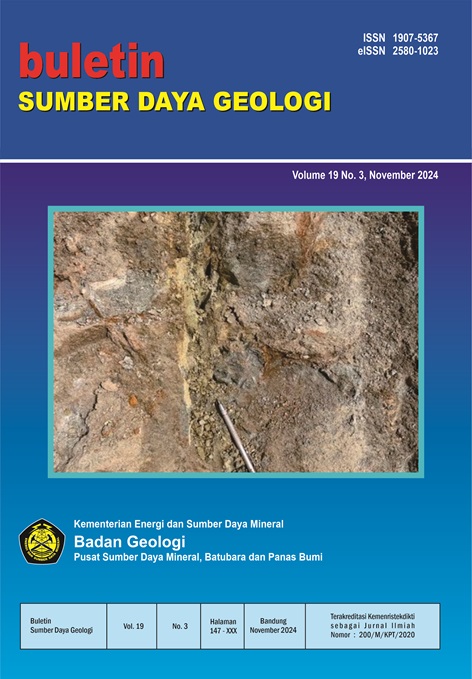ASAL USUL FLUIDA MANIFESTASI PANAS BUMI DAN ESTIMASI TEMPERATUR RESERVOIR DENGAN PENDEKATAN ANALISIS ISOTOP PADA DAERAH DANAU RANAU, OGAN KOMERING ULU (OKU) SELATAN, SUMATERA SELATAN
ORIGIN OF GEOTHERMAL MANIFESTATION FLUID AND DETERMINATION OF RESERVOIR TEMPERATURE USING ISOTOPE ANALYSIS APPROACH IN THE LAKE RANAU AREA, SOUTH OGAN KOMERING ULU (OKU), SOUTH SUMATERA
Abstract
The geothermal potential of the Lake Ranau area comes from the remains of magmatic activity from Mount Seminung. The geothermal manifestation in this area is in the form of hot springs which are thought to arise through geological structures. The existence of geothermal fluid manifestations is very interesting to research, especially regarding the origin and estimation of reservoir temperature using the δ18O and δ2H isotope composition approach. It is important to know the origin of fluid manifestations to determine the potential of geothermal systems from surface manifestations fluid related to magmatic, evaporation or rock interactions. This research method uses isotope analysis to determine the origin of geothermal fluid manifestations and isotope geothermometer to estimate reservoir temperature. Isotope sampling in geothermal manifestation fluids in Kota Batu Village was 3 samples and Lombok Village was 3 samples. The results of isotope analysis on the relationship graph between δ18O and δ2H show that all isotope samples in geothermal manifestation fluids come from meteoric water. The local meteoric water line value equation has a difference in the deuterium excess (DE) value compared to the global meteoric water line value equation. This change in DE value is due to the interaction and mixing process between geothermal fluid and rock (connate water) with the source of evaporation and precipitation from Lake Ranau. The results of isotope geothermometer calculations based on the isotope fractionation factor, it is estimated that the reservoir temperature is around ± 270 0C. Reservoir temperature estimates show that all isotope samples in geothermal manifestation fluids are classified as high temperatures.
Downloads
References
Abidin, Z., Wandowo, Indrojono, Djiono, Alip & Evarista, 1996, Penentuan Temperatur Reservoir Panas Bumi Dengan Metode Geotermometer Isotop, Aplikasi Isotop dan Radiasi.
Afiat, Idianto, O., Rera, G.F., Wardoyo, G.K., Sutopo, Pratama, H.B. & Hamdani, M.R., 2020, Updated Conceptual Model and Resource Assessment using Numerical Reservoir Simulation of Danau Ranau Geothermal Field Indonesia, ITB International Geothermal Workshop 2020, IOP Conf. Series: Earth and Environmental Science, 732 (2021) 012027.
Aggarwal, P., Groening, L., Kulkarni, K.M., Kurttas, T., Newman, B.D. & Tanweer, A., 2009, Laser Spectroscopic Analysis of Liquid Water Samples for Stable Hydrogen and Oxygen Isotopes, IAEA Train. Course Ser. 35.
Aribowo, S., Muslim, D., Winantris, Danny, H., Natawidjaja, Mudrik, R. & Daryono, 2017, Sub-Segmentasi Sesar Pada Segmen Kumering Antara Danau Ranau Hingga Lembah Suoh, Lampung Barat, Jurnal Lingkungan dan Bencana Geologi, Vol. 8 No. 1 Hal 31 – 45.
Badan Geologi, 2023, Neraca Sumber Daya Mineral, Batubara, dan Panas Bumi Indonesia, Pusat Sumber Daya Mineral, Batubara dan Panas Bumi, Badan Geologi, Bandung.
Delattre, H., Vallet-Coulomb, C., & Sonzogni, C., 2015, Deuterium Excess In The Atmospheric Water Vapor of A Mediterranean Coastal Wetland: Regional VS. Local Signatures, Atmospheric Chemistry and Physics. 15, 10167–10181. https://doi.org/10.5194/acp-15-10167-2015
Geyh, M., 2000, Groundwater, Saturated and Unsaturated Zone, In: Mook, W. G. (ed). Environmental Isotopes in The Hydrological Cycle, Principles and Applications. Technical Documents in Hydrology, Vol 4. No 39. UNESCO, Paris.
Giggenbach, W.F., 1992, Isotopic Shifts In Waters From Geothermal and Volcanic Systems Along Convergent Plate Boundaries and Their Origin, Earth Planet. Sci. Lett. 113, 495–510.
Hamed, Y., 2014, Stable Isotope Ratios in Meteoric Waters in El Kef Region, Northwestern Tunisia: Implications for Changes of Moisture Sources, Journal of Earth Science and Climate Change 05, 1–6. https://doi.org/10.4172/21577617.1000203
Hochstein, M.P., 1990, Classification and Assessment of Geothermal Resources, In: Dockson M.H. and Fanelli M. (eds) Small Geothermal Resources, UNITAR/UNDP Centre for Small Energy Resources, Rome, Italy.
Horita, J. & Wesolowski, D.J., 1994, Liquid-vapor fractionation of oxygen and hydrogen isotopes of water from the freezing to the critical temperature, Geochim. Cosmochim. Acta, Vol. 58 No. 16. https://doi.org/10.1016/00167037(94)90096-5
Ibrahim, M.M., Puspita, M., Andarini, D., Marbun, A.G. & Arifianto, D.I., 2020, Identifikasi Dan Interpretasi Geologi Berdasarkan Citra Penginderaan Jauh Pada Daerah Panas Bumi Danau Ranau, Ogan Komering Ulu (OKU) Selatan, Sumatera Selatan, Prosiding Seminar Nasional Teknik Lingkungan Kebumian Ke-II, Vol 2, No 1.
Ibrahim, M.M., Pranata, R., Nababan, B.S., Heriani, N., Maharani, A., Situmorang, A.S.J., Puspita, D., Landia, K. P. & Harfiandri, M.S., 2022, Karakteristik Manifestasi Dan Rekomendasi Pemanfaatan Potensi Panas Bumi Pada Daerah Danau Ranau, Ogan Komering Ulu (OKU) Selatan, Provinsi Sumatera Selatan, Prosiding Seminar Nasional AVoER XIV, Hal 87-91.
Kasbani, 2009, Tipe Sistem Panas Bumi Di Indonesia dan Estimasi Potensi Energinya, Buletin Sumber Daya Geologi, 4 (3):23-30, Badan Geologi, Bandung.
Copyright (c) 2024 Buletin Sumber Daya Geologi

This work is licensed under a Creative Commons Attribution-NonCommercial-ShareAlike 4.0 International License.
Authors whose manuscripts are published agree to the following terms:
The publication rights of all journal manuscript materials published on the Buletin Sumber Daya Geologi website are held by the editorial board with the knowledge of the author (moral rights remain with the manuscript’s author).
The formal legal provisions for access to digital articles in this electronic journal are subject to the terms of the Creative Commons Attribution-ShareAlike (CC BY-SA) license. This means that Buletin Sumber Daya Geologi has the right to store, convert media/formats, manage in the form of a database, maintain, and publish the article without requesting permission from the author, as long as the author’s name is cited as the copyright holder.
Manuscripts published in both print and electronic formats are open access for educational, research, investigative, and library purposes. Beyond these purposes, the editorial board is not responsible for any violations of copyright law.















